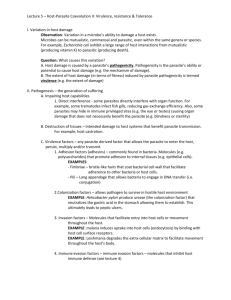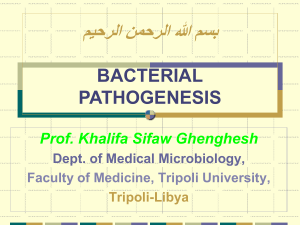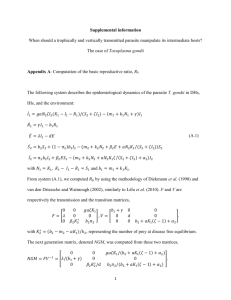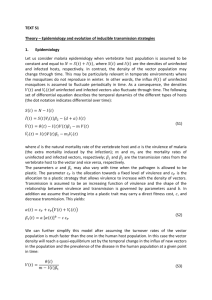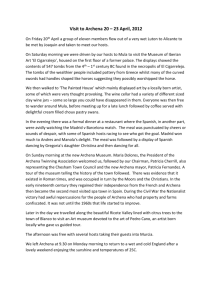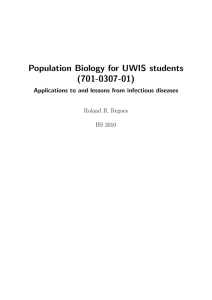Supplementary Information for “Imperfect vaccines and the evolution
advertisement
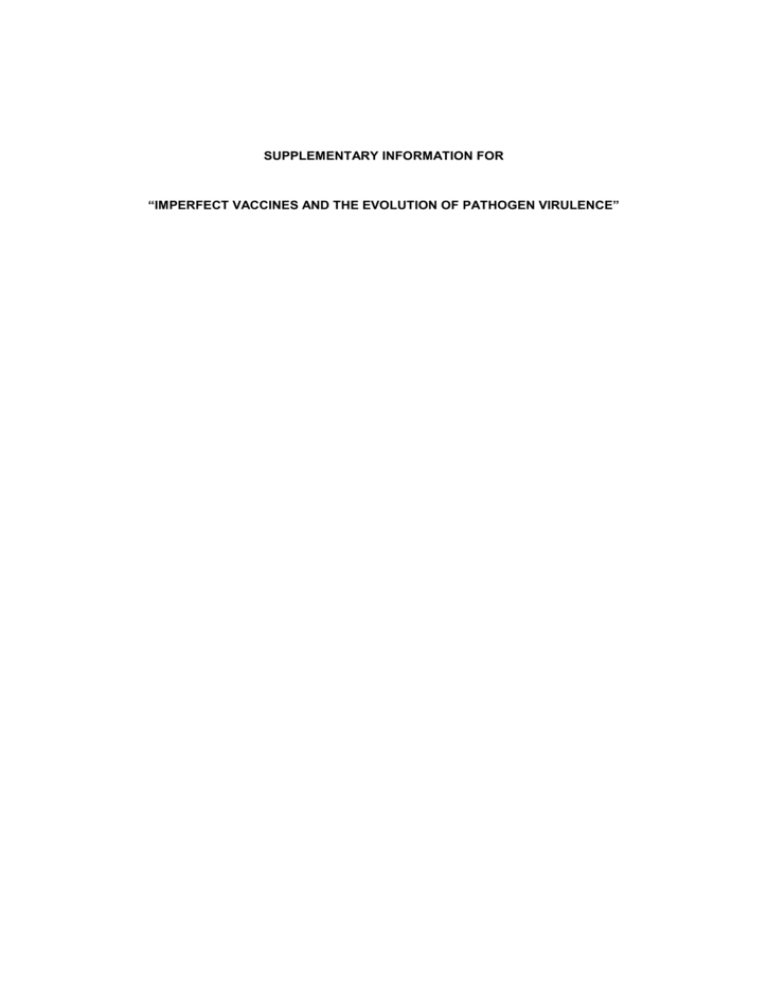
SUPPLEMENTARY INFORMATION FOR “IMPERFECT VACCINES AND THE EVOLUTION OF PATHOGEN VIRULENCE” 2 PARASITE VIRULENCE EVOLUTION IN A HETEROGENEOUS HOST POPULATION 1. Derivation of evolutionarily stable virulence The dynamics of a resident and a mutant parasite (the asterisk refers to the mutant strain) competing in a heterogeneous host population with two types of hosts (the prime refers to resistant hosts) is given by (see main text and Fig. 4 for details): d x / dt 1 f h h* x y * y* d y dt hx y y* h h* y d y dt hx y y* h h* y d y* dt h* x y y* * * h h* y* d y* dt h* x y y* * * h h* y* d x / dt f h h* x y * y* with y y * y* * y* . The direction of evolution and, ultimately the evolutionarily stable (ES) virulence, can be derived from the analysis of the fate of a rare mutant. When the mutant is rare we can neglect its effect on the resident dynamics and focus on its own dynamics which, in matrix form, is given by1: d y* / d t * A* y d y* / dt y* with * N * * h A* *N * N * N * * h 3 where N x y and N 1 r1x y . There are several ways to find the ES parasite virulence from this model. One is to maximise , the dominant eigenvalue of A * , which is the standard measure of fitness for a rare mutant (the rate of invasion when the resident population has reached an equilibrium)2. It is known that, in populations at demographic equilibrium, correct results can also be obtained by maximising the basic reproductive ratio of the mutant strategy, given by equation 7 in the text2. 2. Reproductive values and the strength of selection in different hosts These maximisations must be carried out numerically. As both a check on the numerical calculations, and as a means of gaining insight into their results, a further approach is useful. Maximising the dominant eigenvalue of A* is equivalent to maximising the following function: w* , v A u where v and u are the left and right eigenvectors of A (which is the same as A*, but with the resident's parameters): N N T v and u . These two eigenvectors are, respectively, the individual reproductive values and the frequencies of the two classes of resident parasite infections (i.e. the infections of susceptible or resistant hosts). The product of these two quantities gives the class reproductive values 3 of the two types of parasites. This analysis of reproductive values is particularly insightful since it provides the appropriate fitness weights associated with the selective forces acting in the different types of hosts. For instance, the non-monotonic effect of the efficacy, r2 , of the anti-growth rate vaccine on the ES virulence (Fig. 2a) can be explained with the help of class reproductive values of parasites infecting different types of hosts. Note that the reproductive value of parasites in vaccinated hosts is proportional to 1 r2 . When r2 is low, individual reproductive 4 values are very similar and the direction of evolution at the scale of the whole host population (with both susceptible and vaccinated hosts) is mainly governed by the relative frequencies of the two classes of parasite infections. In this situation, since an increase in vaccine efficacy selects for higher virulence in vaccinated hosts (equations 4 and 5), this yields an increase in the ES virulence. However, when r2 is high, the reproductive value of parasites infecting vaccinated hosts can be very low (when r2 1 , 0 ). This means that, for very efficient vaccines, parasites infecting vaccinated hosts do not contribute to the future of the parasite population. Even though selection for increased virulence is very strong in those hosts, the selective pressures acting in susceptible hosts drive the evolution of the parasite. This explains the drop in ES virulence as r2 1. 5 MALARIA MODEL Here we describe (1) the epidemiological model for malaria under vaccination, allowing for natural immunity and vector transmission, (2) the evolutionary dynamics of a virulence mutant, and (3) the derivation of the evolutionarily stable virulence. 1. Epidemiology We assume there are three types of hosts - naïve, naturally immune and vaccinated, denoted by subscripts N, I and V, respectively - which are infected by a single (resident) strain of parasite. Hosts slowly acquire natural immunity through repeated infections and do not lose this immunity once acquired. This natural immunity comprises all four types and is imperfect, i.e. less than 100% effective. Vaccination with a single vaccine type is assumed to immediately confer the same level of immunity as natural immunity, but only for the type of immunity stimulated by the vaccine. We further assume that the dynamics of the infection processes of the vector happen on a relatively fast time scale, so that the vector dynamics are captured in the equilibrium fraction of infected mosquitoes4,5. Finally, we assume constant host population size yielding the following dynamical equations, with variables and parameters described below: d x N dt 1 f N 1 y N hN xN d xI dt I y I N y N V yV hI xI d xV dt f V 1 yV hV xV d y N dt hN x N N N y N d y I dt hI xI I I y I d yV dt hV xV V V yV Note that, as in equation 6 in the main text, there are no superinfection terms because they cancel out. 1.1. Variables x N , x I , xV : proportions of uninfected hosts 6 y N , y I , yV : proportions of infected hosts N , I ,V : parasite virulence where I (1 2 )(1 4 ) N and V (1 r2 )(1 r4 ) N N , I , V : parasite transmission probabilities (infectivity from infected humans to uninfected mosquitoes) where N [ N ] (see below), I (1 3 ) I and V (1 r3 ) V hN abmzˆ , hI (1 1 )hN and hV (1 r1 )hN hN , hI , hV : forces of infection where ẑ : equilibrium proportion of infectious mosquitoes, given by zˆ a N y N I y I V yV e a N y N I y I V yV : growth/immigration rate of the host population, given by N y N I y I V yV 1.2. Parameters (assumed values in parentheses based on endemic malaria in a high transmission area6-10 with rates given on an annual basis) 1 , 2 , 3 , 4 : resistance of naturally immune hosts (0.8) r1 , r2 , r3 , r4 : vaccine efficacy for different types of vaccines (0.8). We note that this is substantially higher than most current candidate vaccines. N V 1 , I 7 . N , I , V : recovery rates where f : vaccination coverage (0 to 1) : fraction of the recovering individuals that become naturally immune (0.03) 7 : natural host death rate (0.02) a : biting rate on humans by a single mosquito (120) b : infectivity of infected mosquitoes (0.1) m : number of female mosquitoes per human host (5) : mortality rate of the mosquito (infected or not) (50) : latent period in the mosquito (0.04) : susceptibility to superinfection relative to an uninfected host (0.1). Competitive suppression can occur in malaria11 and superinfection events have been directly observed in the field12,13. 2. Invasion dynamics of a mutant The invasion dynamics of a virulent mutant can be described by the following system of differential equations: d xI dt I y I *I y*I N y N V yV *N y*N V* yV* hI hI* xI d xV dt f 1 V yV V* yV* hV hV* xV d x N dt 1 f 1 N y N *N y*N hN h*N x N d y I dt hI x I y I y *I I I hI hI* y I d yV dt hV xV yV yV* V V hV hV* yV d y N dt hN x N y N y *N N N hN h*N y N d y *I dt hI* x I y I y *I *I *I hI hI* y *I d yV* dt hV* xV yV yV* V* V* hV hV* yV* d y *N dt h*N x N y N y *N *N *N hN h*N y *N with 8 N y N I y I V yV *N y*N *I y*I V* yV* hN abm zˆ, hI 1 1 hN , hV 1 r1 hN h*N abm zˆ* , hI* 1 1 h*N , hV* 1 r1 h*N I 1 2 1 4 N , V 1 r2 1 r4 N *I 1 2 1 4 *N , V* 1 r2 1 r4 *N As we assume that the dynamics of the infection processes of the vector happen on a relatively fast time scale, the equilibrium fractions of infected mosquitoes with the resident strain or with the mutant strain are: zˆ a N y N I y I V yV e * * * * * * a N y N I y I V yV N y N I y I V yV ˆ* z * * a N y N I* y *I V* yV* * * a N y N I y I V yV N y N I* y *I V* yV* e The above system of equations can be used to follow the invasion of the parasite population by a virulence mutant after the start of a vaccination campaign (Fig. 5). 3. Derivation of evolutionarily stable virulence As in the simpler model presented earlier, the long-term evolutionary outcome of the parasite population (the evolutionarily stable virulence) can be derived from the analysis of the invasion of a rare mutant when the resident strategy settles at an epidemiological equilibrium. The dynamics of a rare mutant strain appearing in a population of the resident parasite can be put in matrix form: d y *N dt y *N d y *I dt A* y *I * * d yV dt yV with c N* Nˆ N* N* hN c I* Nˆ cV* Nˆ A* c N* Iˆ c I* Iˆ I* I* hI cV* Iˆ c N* Vˆ c I*Vˆ cV*Vˆ V* V* hV 9 and Nˆ xˆ N yˆ N Iˆ 1 1 xˆ I yˆ I Vˆ 1 r xˆ yˆ 1 V V where the hat indicates the equilibrium densities of resident hosts. hN* abm a * N y *N I* yI* V* yV* e c N* y *N I* yI* V* yV* is the force of infection of the mutant on naïve hosts (with c bma2e ) and hI* 1 1 hN* and hV* 1 r1 hN* are the forces of infection of the mutant on immune and vaccinated hosts. Note that we can neglect the terms in y * in the denominator of ẑ * because the mutant is assumed to be rare. Analysis proceeds as with the general model yielding the following expression for the fitness of the virulence mutant: R0 N* , N N* Nˆ V*Vˆ I* Iˆ N* N* hˆN I* I* hˆI V* V* hˆV . We present a numerical example (Fig. 3) with only a trade-off between virulence and transmission given by: N N 1 1.2 5 e1000 N . However, adding a trade-off between virulence and recovery does not qualitatively affect our conclusions. The choice of the particular shape of the trade-off that we used was based on the assumption that observed levels of malaria mortality in non-immune individual5 in endemic areas14,15 are at the parasite’s ES virulence ( N 0.015 ). There are, however, many different trade-off functions which may yield realistic values of the ES virulence. 10 Our model yields the following values for other relevant variables before vaccination: hN 3.5 , N 0.83 , I 0.14 and the fraction of infected hosts that die due to malaria as 1.4% and 0.04% in naïve and naturally immune hosts, respectively14. 1. Gandon, S., van Baalen, M. & Jansen, V. A. A. The evolution of parasite virulence and host resistance. Am. Nat. (Submitted). 2. Caswell, H. Matrix population models: construction, analysis, and interpretation (Sinauer, Sunderland, 2001). 3. Taylor, P. D. Allele-frequency change in a class-structured population. Am. Nat. 135, 95106 (1990). 4. Anderson, R. M. & May, R. M. Infectious Diseases of Humans (Oxford University Press, Oxford, 1991). 5. May, R. M. & Anderson, R. M. Population biology of infectious diseases: Part II. Nature 280, 455-461 (1979). 6. Dietz, K., Molineaux, L. & Thomas, A. in The Garki Project. Research on the Epidemiology and Control of Malaria in the Sudan Savanna of West Africa (eds Molineaux, L. & Gramiccia, G.) 262-289 (World Health Organization, Geneva, 1980). 7. Aron, J. L. & May, R. M. in The Population Dynamics of Infectious Diseases: Theory and Applications 139-179 (Chapman and Hall, London, 1982). 8. Nedelman, J. Inoculation rate and recovery rates in the malaria model of Dietz, Molineaux and Thomas. Math. Biosci. 69, 209-233 (1984). 9. Struchiner, C. J., Halloran, M. E. & Spielman, A. Modeling malaria vaccines I: new uses for old ideas. Math. Biosci. 94, 87-113 (1989). 10. Hay, S. I., Rogers, D. J., Toomer, J. F. & Snow, R. W. Annual Plasmodium falciparum entomological inoculation rates (EIR) across Africa: literature survey, internet access and review. Trans. R. Soc. Trop. Med. Hyg. 94, 113-127 (2000). 11. Read, A. F. & Taylor, L.H. The ecology of genetically diverse infections Science 292, 1099-1102 (2001). 11 12. Mercereau-Puijalon, O. Revisiting host/parasite interactions: molecular analysis of parasites collected during longitudinal and cross-sectional surveys in humans Parasite Immunol. 18, 173-180 (1996). 13. Smith, T., Felger, I., Tanner, M. & Beck, H.-P. The epidemiology of multiple Plasmodium falciparum infections - 11. Premunition in Plasmodium falciparum infection: insights from the epidemiology of multiple infections. Trans. R. Soc. Trop. Med. Hyg. 93, S59-S64 (1999). 14. Snow, R., W., Craig, M., Deichmann, U. & Marsh, K. Estimating mortality, morbidity and disability due to malaria among Africa’s non-pregnant population. Bull. WHO 77, 624-640 (1999). 15. Alles, H. K., Mendis, K. N. & Carter, R. Malaria mortality rates in South Asia and in Africa: implications for malaria control. Parasitol. Today 14, 369-375 (1998).


